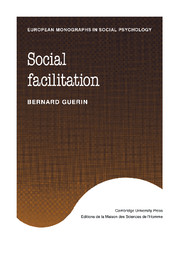Book contents
- Frontmatter
- Contents
- Acknowledgements
- 1 Introduction
- I The history and development of social facilitation research
- II Theories of social facilitation
- III Experimental studies of social facilitation
- IV The place of social facilitation in social psychology
- 9 Integrating the theories of social facilitation
- 10 Related areas of psychology
- 11 Conclusions and future social facilitation research
- References
- Author index
- Subject index
11 - Conclusions and future social facilitation research
Published online by Cambridge University Press: 15 January 2010
- Frontmatter
- Contents
- Acknowledgements
- 1 Introduction
- I The history and development of social facilitation research
- II Theories of social facilitation
- III Experimental studies of social facilitation
- IV The place of social facilitation in social psychology
- 9 Integrating the theories of social facilitation
- 10 Related areas of psychology
- 11 Conclusions and future social facilitation research
- References
- Author index
- Subject index
Summary
The major conclusion of this book must be that social facilitation consists of many phenomena which are common to other social psychological areas of interest (see Geen, 1989, 1991; Paulus, 1983). What defines social facilitation is the particular mix of conditions which is usually present in the social facilitation setting, rather than any defining phenomena such as an increase or decrease in responding.
The animal studies suggested that the changes in the presence of other animals are primarily due to disinhibition of fear responses. When in groups most animals spend less time with fear responses and this facilitates the performance of other behaviours. These other behaviours might be an increase in eating (for chicks), an increase in vigilance (e.g., Lazarus, 1979), or increased social interaction concomitant with decreases in other behaviours such as eating (for rats).
With humans there was some evidence for mere presence effects (Chapter 8). A model based on monitoring was presented as a possible explanation for such effects. While this is obviously not the last word, it at least provides a way of defining mere presence which goes beyond just defining it as the absence of any other effects.
Besides mere presence effects, there were many other phenomena evident in the presence of another person: apprehension about evaluation; changes in self-awareness; increases in self-presentation strategies; increases in behaviours for which other people have become discriminative stimuli; increases in verbal behaviours; behaviour inhibition (at least for rehearsal strategies); physical distraction; cognitive distraction; narrowing of attention; and increases in social comparisons.
- Type
- Chapter
- Information
- Social Facilitation , pp. 186 - 192Publisher: Cambridge University PressPrint publication year: 1993



